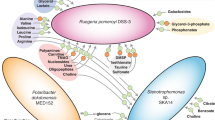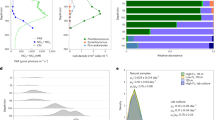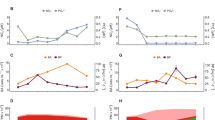Abstract
In vast areas of the oceans, most of the primary production is performed by cells smaller than 2–3 μm in diameter (picophytoplankton). In recent years, several in situ molecular studies showed a broad genetic diversity of small eukaryotes by sequencing 18S rRNA genes. Compared with photosynthetic cyanobacteria that are dominated by two genera, Prochlorococcus and Synechococcus, marine photosynthetic picoeukaryotes (PPEs) are much more diverse, with virtually every algal class being represented. However, the genetic diversity and ecology of PPEs are still poorly described. Here, we show using in situ molecular analyses of psbA transcripts that PPEs in the Eastern Mediterranean Sea are highly diverse, probably very active, and dominated by groups belonging to the red algal lineages, Haptophyta, Heterokontophyta (also called Stramenopiles), and Cryptophyta.
Similar content being viewed by others
Log in or create a free account to read this content
Gain free access to this article, as well as selected content from this journal and more on nature.com
or
Accession codes
References
Andersen RA, Bidigare RR, Keller MD, Latasa M . (1996). A comparison of HPLC pigment signatures and electron microscopic observations for oligotrophic waters of the North Atlantic and Pacific Oceans. Deep Sea Res Part 2 Top Stud Oceanogr 43: 517–537.
Andersen RA, Saunders GW, Paskind MP, Sexton J . (1993). Ultrastructure and 18S rRNA gene sequence for Pelagomonas calceolata gen. and sp. nov. and the description of a new algal class, the Pelagophyceae classis nov. J Phycol 29: 701–715.
Bar-Zeev E, Yogev T, Man-Aharonovich D, Kress N, Herut B, Béjà O et al. (2008). Seasonal dynamics of the endosymbiotic, nitrogen-fixing cyanobacterium Richelia intracellularis in the eastern Mediterranean Sea. ISME J 2: 911–923.
Díez B, Pedrós-Alió C, Marsh TL, Massana R . (2001). Application of denaturing gradient gel electrophoresis (DGGE) to study the diversity of marine picoeukaryotic assemblages and comparison of DGGE with other molecular techniques. Appl Environ Microbiol 67: 2942–2951.
Eikrem W, Romari K, Latasa M, Le Gall F, Throndsen J, Vaulot D . (2004). Florenciella parvula gen. and sp. nov. (Dictyochophyceae, Heterokontophyta) a small flagellate isolated from the english channel. Phycologia 43: 658–668.
Fuller NJ, Campbell C, Allen DJ, Pitt FD, Zwirglmaier K, Le Gall F et al. (2006). Analysis of photosynthetic picoeukaryote diversity at open ocean sites in the Arabian Sea using a PCR biased towards marine algal plastids. Aquat Microb Ecol 43: 79–93.
Guindon S, Gascuel O . (2003). A simple, fast, and accurate algorithm to estimate large phylogenies by maximum likelihood. Syst Biol 52: 696–704.
Le Gall F, Rigaut-Jalabert F, Marie D, Garczareck L, Viprey M, Godet A et al. (2008). Picoplankton diversity in the South-East Pacific Ocean from cultures. Biogeosciences 5: 203–214.
Lepère C, Boucher D, Jardillier L, Domaizon I, Debroas D . (2006). Structure and regulation factors of eukaryotic picoplankton in lacustrine ecosystems. Appl Environ Microbiol 72: 2971–2981.
Lepère C, Vaulot D, Scanlan DJ . (2009). Photosynthetic picoeukaryote community structure in the South East Pacific Ocean encompassing the most oligotrophic waters on earth. Environ Microbiol 11: 3105–3117.
Li WKW . (1994). Primary production of prochlorophytes, cyanobacteria, and eucaryotic ultraphytoplankton: measurements from flow cytometric sorting. Limnol Oceanogr 39: 169–175.
Li WKW . (1995). Composition of ultraphytoplankton in the central North Atlantic. Mar Ecol Prog Ser 122: 1–8.
Li WKW . (2009). From cytometry to macroecology: a quarter century quest in microbial oceanography. Aquat Microb Ecol 57: 239–251.
Li WKW, Zohary T, Yacobi YZ, Wood AM . (1993). Ultraphytoplankton in the eastern Mediterranean Sea—towards deriving phytoplankton biomass from flow cytometric measurements of abundance, fluorescence and light scatter. Mar Ecol Prog Ser 102: 79–87.
Liu H, Probert I, Uitz J, Claustre H, Aris-Brossou S, Frada M et al. (2009). Haptophyta rule the waves: extreme oceanic biodiversity in non-calcifying haptophytes explains the 19-Hex paradox. Proc Natl Acad Sci USA 106: 12803–12808.
López-García P, Rodríguez-Valera F, Pedrós-Alió C, Moreira D . (2001). Unexpected diversity of small eukaryotes in deep-sea Antarctic plankton. Nature 409: 603–607.
Man-Aharonovich D, Kress N, Bar Zeev E, Berman-Frank I, Béjà O . (2007). Molecular ecology of nifH genes and transcripts in Eastern Mediterranean Sea. Environ Microbiol 9: 2354–2363.
Marañón E, Holligan PM, Barciela R, Gonzalez N, Mourino B, Pazo MJ et al. (2001). Patterns of phytoplankton size structure and productivity in contrasting open-ocean environments. Mar Ecol Prog Ser 216: 43–56.
Marie D, Zhu F, Balagué V, Ras J, Vaulot D . (2006). Eukaryotic picoplankton communities of the Mediterranean Sea in summer assessed by molecular approaches (DGGE, TTGE, QPCR). FEMS Microbiol Ecol 55: 403–415.
Massana R, Karniol B, Pommier T, Bodaker I, Béjà O . (2008). Metagenomic retrieval of a ribosomal DNA repeat array from an uncultured marine alveolate. Environ Microbiol 10: 1335–1343.
Massana R, Murray AE, Preston CM, DeLong ED . (1997). Vertical distribution and phylogenetic characterization of marine planktonic Archaea in the Santa Barbara channel. Appl Environ Microbiol 63: 50–56.
Massana R, Unrein F, Rodriguez-Martinez R, Forn I, Lefort T, Pinhassi J et al. (2009). Grazing rates and functional diversity of uncultured heterotrophic flagellates. ISME J 3: 588–596.
McDonald SM, Sarno D, Scanlan DJ, Zingone A . (2007). Genetic diversity of eukaryotic ultraphytoplankton in the Gulf of Naples during an annual cycle. Aquat Microb Ecol 50: 75–89.
Moon-van der Staay SY, De Wachter R, Vaulot D . (2001). Oceanic 18S rDNA sequences from picoplankton reveal unsuspected eukaryotic diversity. Nature 409: 607–610.
Not F, del Campo J, Balagué V, de Vargas C, Massana R . (2009). New insights into the diversity of marine picoeukaryotes. PLoS ONE 4: e7143.
Not F, Latasa M, Marie D, Cariou T, Vaulot D, Simon N . (2004). A single species Micromonas pusilla (Prasinophyceae) dominates the eukaryotic picoplankton in the western english channel. Appl Environ Microbiol 70: 4064–4072.
Not F, Latasa M, Scharek R, Viprey M, Karleskind P, Balagué V et al. (2008). Protistan assemblages across the Indian Ocean, with a specific emphasis on the picoeukaryotes. Deep Sea Res I 55: 1456–1473.
Prokopowich CD, Gregory TR, Crease TJ . (2003). The correlation between rDNA copy number and genome size in eukaryotes. Genome 46: 48–50.
Schloss PD, Handelsman J . (2005). Introducing DOTUR, a computer program for defining operational taxonomic units and estimating species richness. Appl Environ Microbiol 71: 1501–1506.
Schloss PD, Handelsman J . (2006). Introducing SONS, a tool for operational taxonomic unit-based comparisons of microbial community memberships and structures. Appl Environ Microbiol 72: 6773–6779.
Sharon I, Tzahor S, Williamson S, Shmoish M, Man-Aharonovich D, Rusch DB et al. (2007). Viral photosynthetic reaction center genes and transcripts in the marine environment. ISME J 1: 492–501.
Shi XL, Marie D, Jardillier L, Scanlan DJ, Vaulot D . (2009). Groups without cultured representatives dominate eukaryotic picophytoplankton in the oligotrophic South East Pacific Ocean. PLoS ONE 4: e7657.
Sieburth JM, Smetacek V, Lenz J . (1978). Pelagic ecosystem structure: heterotrophic components of the plankton and their relationship to plankton size fractions. Limnol Oceanogr 23: 1256–1263.
Stoeck T, Zuendorf A, Breiner HW, Behnke A . (2007). A molecular approach to identify active microbes in environmental eukaryote clone libraries. Microb Ecol 53: 328–339.
Thomsen HA . (1986). A survey of the smallest eukaryotic organisms of the marine phytoplankton. Can Bull Fish Aquat Sci 214: 121–158.
Tzahor S, Man-Aharonovich D, Kirkup BC, Yogev T, Berman-Frank I, Polz M et al. (2009). A supervised learning approach for taxonomic classification of core-photosystem-II genes and transcripts in the marine environment. BMC Genomics 10: 229.
Vaulot D, Eikrem W, Viprey M, Moreau H . (2008). The diversity of small eukaryotic phytoplankton (⩽3 μm) in marine ecosystems. FEMS Microbiol Rev 32: 795–820.
Vaulot D, Le Gall F, Marie D, Guillou L, Partensky F . (2004). The Roscoff Culture Collection (RCC): a collection dedicated to marine picoplankton. Nova Hedwigia 79: 49–70.
Vaulot D, Romari K, Not F . (2002). Are autotrophs less diverse than heterotrophs in marine picoplankton? Trends Microbiol 10: 266–267.
Verity PG, Robertson CY, Tronzo CR, Andrews MG, Nelson JR, Sieracki ME . (1992). Relationships between cell volume and the carbon and nitrogen content of marine photosynthetic nanoplankton. Limnol Oceanogr 37: 1434–1446.
Wang K, Chen F . (2008). Prevalence of highly host-specific cyanophages in the estuarine environment. Environ Microbiol 10: 300–312.
Worden AZ, Nolan JK, Palenik B . (2004). Assessing the dynamics and ecology of marine picophytoplankton: The importance of the eukaryotic component. Limnol Oceanogr 49: 168–179.
Zeidner G, Béjà O . (2004). The use of DGGE analyses to explore eastern Mediterranean and Red Sea marine picophytoplankton assemblages. Environ Microbiol 6: 528–534.
Zeidner G, Preston CM, Delong EF, Massana R, Post AF, Scanlan DJ et al. (2003). Molecular diversity among marine picophytoplankton as revealed by psbA analyses. Environ Microbiol 5: 212–216.
Zhang Z, Green BR, Cavalier-Smith T . (2000). Phylogeny of ultra-rapidly evolving dinoflagellate chloroplast genes: a possible common origin for sporozoan and dinoflagellate plastids. J Mol Evol 51: 26–40.
Zhu F, Massana R, Not F, Marie D, Vaulot D . (2005). Mapping of picoeucaryotes in marine ecosystems with quantitative PCR of the 18S rRNA gene. FEMS Microbiol Ecol 52: 79–92.
Acknowledgements
We thank the sequencing team in the MPI for Molecular Genetic in Berlin for technical support and the captain and crew of the R/V Med Explorer for their expert assistance at sea. We are grateful to Feng Chen and Kui Wang for allowing us to use their psbA primers prior to publication and to Ramon Massana for help during the initial stages of the project. This research was supported in part by an Israel Science Foundation Grant (no. 458/04, IB-F & OB), an EMBO YIP award (OB), a Marine Genomics Network Of Excellence EU grant (OB), and a grant by the Gordon and Betty Moore Foundation and US Department of Energy Genomes to Life (MFP). Strains were provided by the Roscoff Culture Collection supported by the Contrat de Plan Etat-Région Souchothèque de Bretagne and by the ASSEMBLE EU FP7 research infrastructure initiative. This research is part of the requirements for a PhD thesis for TY at Bar-Ilan University.
Author information
Authors and Affiliations
Corresponding author
Additional information
Supplementary Information accompanies the paper on The ISME Journal website
Rights and permissions
About this article
Cite this article
Man-Aharonovich, D., Philosof, A., Kirkup, B. et al. Diversity of active marine picoeukaryotes in the Eastern Mediterranean Sea unveiled using photosystem-II psbA transcripts. ISME J 4, 1044–1052 (2010). https://doi.org/10.1038/ismej.2010.25
Received:
Revised:
Accepted:
Published:
Issue date:
DOI: https://doi.org/10.1038/ismej.2010.25
Keywords
This article is cited by
-
A light-induced shortcut in the planktonic microbial loop
Scientific Reports (2016)
-
Molecular Detection, Quantification, and Diversity Evaluation of Microalgae
Marine Biotechnology (2012)
-
Metatranscriptomic analysis of autonomously collected and preserved marine bacterioplankton
The ISME Journal (2011)



